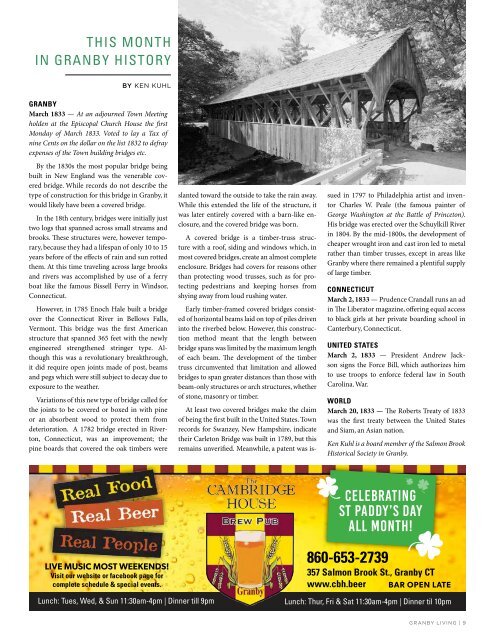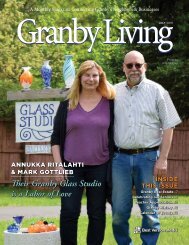Granby Living Mar2018
Create successful ePaper yourself
Turn your PDF publications into a flip-book with our unique Google optimized e-Paper software.
THIS MONTH<br />
IN GRANBY HISTORY<br />
BY KEN KUHL<br />
GRANBY<br />
March 1833 — At an adjourned Town Meeting<br />
holden at the Episcopal Church House the first<br />
Monday of March 1833. Voted to lay a Tax of<br />
nine Cents on the dollar on the list 1832 to defray<br />
expenses of the Town building bridges etc.<br />
By the 1830s the most popular bridge being<br />
built in New England was the venerable covered<br />
bridge. While records do not describe the<br />
type of construction for this bridge in <strong>Granby</strong>, it<br />
would likely have been a covered bridge.<br />
In the 18th century, bridges were initially just<br />
two logs that spanned across small streams and<br />
brooks. These structures were, however temporary,<br />
because they had a lifespan of only 10 to 15<br />
years before of the effects of rain and sun rotted<br />
them. At this time traveling across large brooks<br />
and rivers was accomplished by use of a ferry<br />
boat like the famous Bissell Ferry in Windsor,<br />
Connecticut.<br />
However, in 1785 Enoch Hale built a bridge<br />
over the Connecticut River in Bellows Falls,<br />
Vermont. This bridge was the first American<br />
structure that spanned 365 feet with the newly<br />
engineered strengthened stringer type. Although<br />
this was a revolutionary breakthrough,<br />
it did require open joints made of post, beams<br />
and pegs which were still subject to decay due to<br />
exposure to the weather.<br />
Variations of this new type of bridge called for<br />
the joints to be covered or boxed in with pine<br />
or an absorbent wood to protect them from<br />
deterioration. A 1782 bridge erected in Riverton,<br />
Connecticut, was an improvement; the<br />
pine boards that covered the oak timbers were<br />
slanted toward the outside to take the rain away.<br />
While this extended the life of the structure, it<br />
was later entirely covered with a barn-like enclosure,<br />
and the covered bridge was born.<br />
A covered bridge is a timber-truss structure<br />
with a roof, siding and windows which, in<br />
most covered bridges, create an almost complete<br />
enclosure. Bridges had covers for reasons other<br />
than protecting wood trusses, such as for protecting<br />
pedestrians and keeping horses from<br />
shying away from loud rushing water.<br />
Early timber-framed covered bridges consisted<br />
of horizontal beams laid on top of piles driven<br />
into the riverbed below. However, this construction<br />
method meant that the length between<br />
bridge spans was limited by the maximum length<br />
of each beam. The development of the timber<br />
truss circumvented that limitation and allowed<br />
bridges to span greater distances than those with<br />
beam-only structures or arch structures, whether<br />
of stone, masonry or timber.<br />
At least two covered bridges make the claim<br />
of being the first built in the United States. Town<br />
records for Swanzey, New Hampshire, indicate<br />
their Carleton Bridge was built in 1789, but this<br />
remains unverified. Meanwhile, a patent was issued<br />
in 1797 to Philadelphia artist and inventor<br />
Charles W. Peale (the famous painter of<br />
George Washington at the Battle of Princeton).<br />
His bridge was erected over the Schuylkill River<br />
in 1804. By the mid-1800s, the development of<br />
cheaper wrought iron and cast iron led to metal<br />
rather than timber trusses, except in areas like<br />
<strong>Granby</strong> where there remained a plentiful supply<br />
of large timber.<br />
CONNECTICUT<br />
March 2, 1833 — Prudence Crandall runs an ad<br />
in The Liberator magazine, offering equal access<br />
to black girls at her private boarding school in<br />
Canterbury, Connecticut.<br />
UNITED STATES<br />
March 2, 1833 — President Andrew Jackson<br />
signs the Force Bill, which authorizes him<br />
to use troops to enforce federal law in South<br />
Carolina. War.<br />
WORLD<br />
March 20, 1833 — The Roberts Treaty of 1833<br />
was the first treaty between the United States<br />
and Siam, an Asian nation.<br />
Ken Kuhl is a board member of the Salmon Brook<br />
Historical Society in <strong>Granby</strong>.<br />
CELEBRATING<br />
ST PADDY’S DAY<br />
ALL MONTH!<br />
LIVE MUSIC MOST WEEKENDS!<br />
Visit our website or facebook page for<br />
complete schedule & special events.<br />
Lunch: Tues, Wed, & Sun 11:30am-4pm | Dinner till 9pm<br />
860-653-2739<br />
357 Salmon Brook St., <strong>Granby</strong> CT<br />
www.cbh.beer BAR OPEN LATE<br />
Lunch: Thur, Fri & Sat 11:30am-4pm | Dinner til 10pm<br />
GRANBY LIVING | 9


















